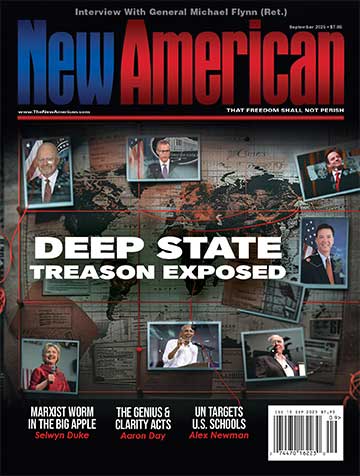As the Ford Taurus slowly approached the signal site, hidden FBI agents readied for a possible arrest. For weeks they had been staking out a path in Foxstone Park in Vienna, Virginia, outside Washington, D.C. Their elusive quarry was a Soviet mole in the FBI, codenamed “Ramon Garcia.”
Over the course of more than two decades, “Ramon” had done incalculable damage to the United States’ security, selling Top Secret information to the Soviet GRU (military intelligence) and KGB, and to the KGB’s Russian successor agency, the FSB, and its foreign arm, the SVR.
Would “Ramon” stop this time? More than a month earlier he had placed a piece of adhesive tape on the park’s signpost. He had been passing by the post frequently — often several times on the same day — to check for a response from the Russians. On January 23, 2001, an FBI agent had reported, “Target drove past Foxstone Park signal site shortly before six p.m. Came virtually to a stop, then drove away.” Three days later the agent reported that “Ramon” had driven by the post three times, about an hour apart, at 5:37 p.m., 6:42 p.m., and 7:44 p.m.
He was early today — almost two hours ahead of the time he had arranged with his Russian contacts. But this appeared to be the real thing. “Ramon” parked the Taurus and got out. He walked down the trail a couple hundred yards through the woods to a footbridge, one of his “dead drops.” He looked nervously about and then taped a package under the corner of the bridge. He was nearly back to his car when the command over a bullhorn brought him to a halt: “Freeze! Freeze exactly where you are! Do not move!”
Half a dozen FBI agents sprang from behind a blind and surrounded him. Two days after the arrest, at a February 20, 2001 press conference, FBI Director Louis J. Freeh announced that Soviet-Russian spy “Ramon” was actually one of the FBI’s top counterintelligence specialists, Robert Philip Hanssen.
According to Director Freeh, “Hanssen provided to the former Soviet Union and subsequently to Russia substantial volumes of highly classified information that he acquired during the course of his job responsibilities in counterintelligence. In return, he received large sums of money and other remuneration. The complaint alleges that he received over $600,000.” Freeh noted the “full extent of the damage done is yet unknown,” but characterized it as “exceptionally grave.”
Hanssen, charged the federal grand jury indictment, “did knowingly and unlawfully combine, confederate, and agree with other persons … including officers of the KGB/SVR, to knowingly and unlawfully communicate, deliver, and transmit to foreign governments, specifically the Union of Soviet Socialist Republics (USSR) and its successor, the Russian Federation … documents and information relating to the national defense of the United States,” with the knowledge that the same “would be used to the injury of the United States.”
“The information he is alleged to have provided,” said Freeh, “compromised numerous human sources, technical operations, counterintelligence techniques, sources and methods, and investigations.” There was blood on Hanssen’s hands. He had, said Freeh, “disclosed the identity of two KGB officials who … had been recruited by the U.S. Government.” Both of these agents, Freeh noted, were arrested, tried, and executed after they had returned to Russia. Subsequent reports indicate Hanssen may have been responsible for the deaths of two additional defectors.
Hanssen, Putin, and 9/11
The sensational capture of the top-level Soviet/Russian mole in one of our nation’s most sensitive intelligence posts, however, was largely forgotten a few months later when the far more sensational September 11 terrorist attacks captivated world attention. This was both ironic and tragic since the 9/11 attacks should have been viewed (and should be viewed now) in the context of — and in connection with — the enormous national security compromises revealed in the Hanssen espionage fiasco. All of the context and connections of the Hanssen-Russia-al-Qaeda-9/11 nexus are still not known, but the evidence and information available thus far indicates that the much-lamented intelligence failures that left America vulnerable on September 11, 2001 have been vastly compounded by even greater misdirection of our intelligence in the “War on Terror” ever since. We are referring specifically to the misdirection of our intelligence away from consideration of evidence that the 9/11 al-Qaeda attacks were a strategic operation sponsored by our new “ally,” Russia.
The policy “experts” who dominate our governing institutions, think tanks, universities, and major media were virtually unanimous in singing paeans of praise to Russian President Vladimir Putin for being the first world leader to express condolences and support during our tragedy. Even today, after several years of steady marching toward a renewed form of Stalinist-style, Soviet governance, the Putin-Medvedev regime in Moscow is viewed by much of our so-called intelligentsia as the indispensable partner in a global battle against radical Islam.
Dr. Michael A. McFaul of the Carnegie Endowment (and a frequent media go-to expert on Russia) is typical of the dominant mindset. He writes, on the Carnegie website:
On September 11th, Putin did not hesitate to call his new friend, George W. Bush, to communicate his full support for the United States and the American people. Putin did not let a decade of unfulfilled expectations in U.S.-Russian relations color his rhetorical response. While some leaders and people around the world believe that the United States “got what it deserved” on September 11th, Putin expressed sympathy as a leader of a country that also has suffered from acts of terrorism against civilians in the capital.
The following Monday, September 24th, Putin announced a five-point plan to support the American war against terrorism.
“The potential to build a new foundation for Russian-American relations is great,” McFaul says, and we must not allow this “window of opportunity” to be wasted. “Leaders in both countries must lead,” he insists. “They must act boldly, abandon business as usual, take chances, and use this moment to map the path to a new future.” (Dr. McFaul is now senior director for Russia on the Obama administration’s National Security Council.)
Notwithstanding the Kremlin’s increasingly tyrannical rule, many of our policy elites continue to share Dr. McFaul’s deadly illusions vis-à-vis Russia and the threat of global terrorism. More sober-minded realists would have viewed Putin’s 9/11 condolences and offers of support in much the same vein as they would the Mafia godfather who sends flowers to the funeral of the rival he’s just rubbed out and cries crocodile tears as he expresses condolences to the victim’s widow and children, assuring them that he will spare no effort to find who did the foul deed.
The PROMIS Connection
One of the important early bits of information that leaked out to link Hanssen, Putin, and 9/11 concerned references to Hanssen’s alleged delivery of copies of the FBI’s enhanced version of the controversial PROMIS computer software to the KGB/FSB. The Russians then, reportedly, provided a copy of the software to Osama bin Laden, thus facilitating al-Qaeda’s money laundering and other activities, as well as enabling al-Qaeda to monitor and evade U.S. law enforcement, intelligence, and military efforts to kill or capture them.
Developed in the 1980s by Inslaw, Inc. as a powerful case-management, people-tracking program for the U.S. Justice Department, the PROMIS (Prosecutors Management Information Systems) software has been the source of ongoing litigation and investigation. In 1985, Inslaw launched a suit against Justice, claiming that the Justice Department had defrauded it of millions of dollars in licensing and service fees. Inslaw charged, moreover, that the government had illegally converted PROMIS into a covert intelligence tool, which it sold to other governments, with a Trojan horse trap door, in order to spy on those governments.
In 2001, a number of stories — in the Washington Times, Washington Post, and Fox News — reported that PROMIS-derivative software provided to the Soviets by Hanssen had found its way to bin Laden. An October 16 Fox News report, for instance, provided this exchange between anchor Brit Hume and correspondent Carl Cameron:
HUME: There’s now a disturbing indication that Robert Hanssen, the FBI man accused of spying for the Russians in what officials said at the time of his arrest was a massive security breach, ended up helping Osama bin Laden.
As correspondent Carl Cameron reports, Hanssen sold the Russians an extremely sensitive piece of U.S. technology, and the indications are that they, in turn, sold it to bin Laden’s al-Qaeda terrorist network. Carl.
CAMERON: Fox News has learned that government officials suspect Osama bin Laden may have highly sophisticated U.S. government software, that has been used by several governments, including the United States, for classified intelligence and law enforcement information.
Bin Laden allegedly purchased it from Russian sources, after Russia got it from convicted spy and former FBI agent Robert Hanssen, who was nabbed earlier this year….
The software program is called PROMIS. Sources tell Fox that U.S. law enforcement and intelligence agencies have used and constantly modified PROMIS software to manage caseloads, track and store classified information, and keep it secure for decades.
But the concern is that bin Laden or al-Qaeda could get online and use it to monitor the worldwide criminal investigation and hide themselves, to monitor the worldwide financial investigation and hide their money, or monitor government operations of the governments that use the software.
As a senior agent in the FBI’s counterterrorism bureau, sources say Hanssen was tasked with helping allies like Germany and England with the installation and use of their versions of the PROMIS program. Numerous countries now, however, are tightening their cyber security. Germany stopped using PROMIS software just last week. Great Britain began closing it down just a few months ago. Canada has actually investigated potential tampering with its PROMIS programs, and Israel has used it on and off for years, too.
In its case against Hanssen, the U.S. government did not mention PROMIS directly, but government sources say PROMIS-derived software programs were at the heart of the case. The lengthy FBI affidavit supporting the criminal complaint notes that Hanssen made extensive unauthorized use of the FBI’s Automated Case Support (ACS) system, reportedly a PROMIS derivative, to obtain information for the KGB/SVR and to monitor the FBI’s search for the Soviet mole (Hanssen) within the bureau. The affidavit does not explicitly say that Hanssen gave a copy of the ACS software to his Soviet/Russian co-conspirators, but it does say he gave them 26 computer diskettes and more than 6,000 pages of documents in the 27 letters and 33 packages he delivered to them over the years.
ComPROMISed Intelligence
Among the highly sensitive software programs that may have been included in those deliveries are the FBI’s Field Office Information Management Systems (FOIMS) and the Community On-Line Intelligence Systems (COINS), both, reportedly, PROMIS derivatives. In the aforementioned FBI affidavit, the government goes as far as saying Hanssen gave the KGB/SVR “an official technical document describing COINS-II,” which was, said the document, “the then-current version of the United States Intelligence Community’s ‘Community On-Line Intelligence System,’ which constituted a classified Community-wide intranet.”
It is not likely the government will confirm or refute the Hanssen-PROMIS-Russia-bin Laden thesis (or provide documents to publicly settle the matter) any time soon. However, quite apart from that important issue, the Hanssen case exposes the dangerous schizophrenia that exemplifies our relations with Russia, most especially as it relates to national security and terrorism.
The federal indictment of Robert Hanssen charges that the 25-year FBI veteran “did knowingly and unlawfully combine, confederate, and agree with other persons … including officers of the KGB/SVR, to knowingly and unlawfully communicate, deliver, and transmit to foreign governments, specifically the Union of Soviet Socialist Republics (USSR) and its successor, the Russian Federation … documents and information relating to the national defense of the United States,” with the knowledge that the same “would be used to the injury of the United States.”
“It was further a part of the conspiracy,” claims the indictment, “that the defendant HANSSEN’s espionage relationship with the USSR was converted into an espionage relationship with the Russian Federation after the USSR dissolved and the Russian Federation came into existence.”
Robert Hanssen began his betrayal of the United States by providing crucial American secrets to the Soviet GRU and KGB, which Vladimir Putin and much of the current crop of Russian leaders then worked for. Hanssen ended his treasonous career conspiring with the Russian FSB/SVR, which Putin and company now run and oversee. There is virtually no difference — other than cosmetic changes in labels and uniforms — between the KGB and FSB/SVR or between the Soviet and Russian leadership. There is continuity — of personnel, methods, and objectives — from one to the other.
The Hanssen case is far from being the only example of this KGB-to-FSB continuity. In 1996, five years before Hanssen’s arrest, FBI special agent Earl Edwin Pitts was arrested for selling secrets to the Soviet Union and Russia. In 1994, CIA counterintelligence agent Aldrich Hazen Ames was arrested for his ongoing espionage for the KGB and FSB/SVR. Ames’ nine-year career of betrayal resulted in devastating intelligence and national security losses for the United States. In June 2001, less than three months before 9/11, U.S. Army Colonel George Trofimoff, a military intelligence analyst, was convicted of spying for the Soviet Union and Russia over a 25-year period. These cases and others more than vindicate former CIA counterintelligence chief James J. Angleton and Soviet defector Anatoliy Golitsyn, who argued that overwhelming evidence indicated there were high-level moles within our intelligence community. They and their warnings were disparaged, discounted, and dismissed — with disastrous consequences for our nation. Unfortunately, Robert Hanssen was not the last mole; we can be virtually certain there are others.
Blindness and Betrayal
The KGB-FSB continuity does not extend merely to espionage; it also includes all of the traditional KGB activities: active measures, disinformation, propaganda, assassination — and terrorism. As The New American has demonstrated in a series of articles, the modern terrorism phenomenon, which was launched by the Soviet KGB in the 1960s and ’70s, is continuing today under the auspices of the Russian FSB (available soon at www.exposingterrorism.com). The main difference today is that the Kremlin strategists have determined that it will be far more effective — for many reasons — for them to run their terror operations as deniable assets under the banner of Islam.
There is another major difference; while Putin and the Russian Politburo continue to use terrorism as a form of asymmetric warfare against us, our leaders insist on pretending it isn’t happening. In fact, they insist Putin & Co. are our trusted “allies” against terrorism. The Obama administration is continuing the course set by George W. Bush in the aftermath of the 9/11 attacks. In a “Joint Declaration on a New Relationship Between the United States and Russia,” Presidents Bush and Putin said on May 24, 2002, that our countries had “embarked upon the path of new relations for the twenty-first century,” and are “committed to developing a relationship based on friendship, cooperation, common values, trust, openness, and predictability.”
They further declared:
We are achieving a new strategic relationship. The era in which the United States and Russia saw each other as an enemy or strategic threat has ended. We are partners and we will cooperate to advance stability, security, and economic integration, and to jointly counter global challenges and to help resolve regional conflicts.
Pardon me for puncturing the balloon, but it must be noted that we’ve been treated to this spectacle before. Few may recall that several years before he was faced with the unpleasant task of announcing traitor Robert Hannsen’s “exceptionally grave” betrayals to the KGB/FSB, Bill Clinton’s FBI Director Louis Freeh was singing the praises of the KGB/FSB claque running Russia. On July 4, 1994, Freeh was in Moscow opening the FBI’s first legal attaché office in Russia and joining Russian Interior Minister Viktor Yerin in signing a protocol for close cooperation between the FBI and FSB. “We can honestly say that our two nations have more in common than ever before…. We are united in purpose and in spirit,” declared Freeh. FSB boss Sergei Stepashin was even more jubilant. “Together, we’re invincible,” he effused. Clinton’s Assistant Secretary of State Richard Holbrooke was only slightly less giddy about the new relationship . “We are in a new phase of foreign policy,” he declared. “The FBI is moving to the forefront of this new foreign policy.” Mr. Holbrooke, a director and leading light at the globalist Council on Foreign Relations, is now a key adviser to the Obama administration and its point man on Afghanistan and Pakistan.
— Photo: AP Images




